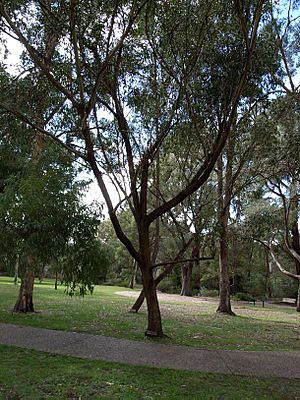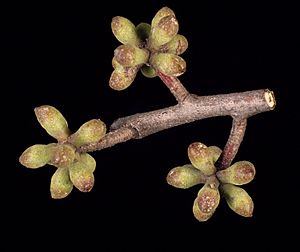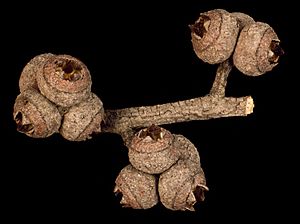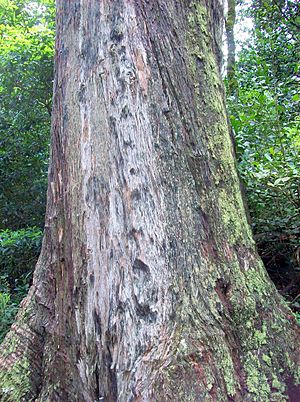Blaxland's stringybark facts for kids
Quick facts for kids Blaxland's stringybark |
|
|---|---|
 |
|
| Eucalyptus blaxlandi in the ANBG | |
| Scientific classification | |
| Genus: |
Eucalyptus
|
| Species: |
blaxlandii
|
Blaxland's stringybark, also known as Eucalyptus blaxlandii, is a type of tree found only in southeastern New South Wales, Australia. It's called a "stringybark" because of its rough, stringy bark. This tree has special lance-shaped leaves, white flowers, and fruit that looks like a small, round cap.
Contents
What Does Blaxland's Stringybark Look Like?
Blaxland's stringybark is a tall tree. It can grow up to 30–35 metres (98–115 ft) high. It has a special woody swelling at its base called a lignotuber. This helps the tree regrow after a fire.
The bark on the main trunk and bigger branches is rough and stringy. It's usually dark brown to grayish. The bark on the thinner branches is smooth and whitish.
Leaves and Flowers
Young plants have shiny, lance-shaped or egg-shaped leaves. These leaves are about 40–80 mm (1.6–3.1 in) long. They are a different shade of green on each side.
Adult leaves are lance-shaped and about 60–120 mm (2.4–4.7 in) long. They are the same slightly shiny green on both sides. Each leaf has a small stem called a petiole.
The flowers usually grow in groups of nine or eleven. They appear where the leaves meet the stem (called a leaf axil). Each group of flowers grows on a stalk called a peduncle. The individual flower buds are oblong or oval. They are about 6 mm (0.24 in) long. Each bud has a rounded cap, called an operculum, which falls off when the flower opens.
Blaxland's stringybark has white flowers. They have been seen blooming in March and November.
Fruit
After flowering, the tree produces woody fruit. This fruit is a small, round capsule. It is about 4–6 mm (0.16–0.24 in) long and 7–13 mm (0.3–0.5 in) wide. The fruit sits directly on the stem without a stalk, which is called being sessile. The seeds are held inside this capsule.
How Did Blaxland's Stringybark Get Its Name?
The scientific name for this tree, Eucalyptus blaxlandii, was first officially written down in 1919. This was done by two botanists, Joseph Maiden and Richard Hind Cambage. They studied a tree found in Blackheath, New South Wales.
The second part of the name, blaxlandii, is a tribute to Gregory Blaxland. He was a famous explorer. Gregory Blaxland led the first group of Europeans to cross the Blue Mountains (New South Wales). Many of these stringybark trees are found in that area.
Where Does Blaxland's Stringybark Grow?
Blaxland's stringybark grows in forests. It prefers areas with sandstone soil. You can find it in the Central Tablelands and Southern Tablelands of New South Wales. Its range stretches from Nullo Mountain near Kandos down to the Dampier State Forest near Bodalla.




